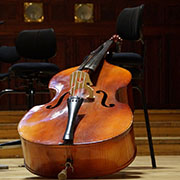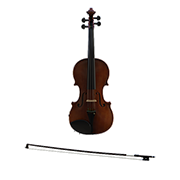The first thing you will notice about stringed devices is that they feature wood. These devices have hollow bodies such that sounds can vibrate in them, creating different tones. The vibrating sounds result from the strumming of strings, and you will find that to play them; you often need to draw the bow across the devices. The bow has a wooden handle while the strings could be of any material, including nylon. Playing the device will depend on what you find comfortable. Some people like strumming the strings and there are those who will turn the device upside down and use a wooden handle for the same.
This family makes up for the largest group of devices that you will find in a lineup. Their sizes vary such that they produce different tones. The smaller the device, the higher the pitch produced and the vice versa holds. The one thing that this family devices have in common is their design. They all have curvy bodies made of wood with strings running through the body towards decorative heads at the end. These heads allow for tuning to take place.
Let’s have a look at each device:
The Double Bass

This device is the largest in this family with a length of six feet. Many people think of it as the grandparent in the group. Owing to its large size, people playing this device often have to stand. You could also sit on a high stool when doing so as it all depends on what you find comfortable. In an ensemble, there will be about six such instruments in the lineup, and they contribute to the warm low notes that you hear.
The Violin

This device is the baby of the group as it is quite small. And it lives up to its name for just like a baby; it makes the most high-pitched sounds. In an ensemble, you will find that the devices are mainly violins which often fall into two groups known as the first and the second. The first group plays the refrain while the other class swiftly moves between the euphony and the refrain.
A violin will measure anything from two feet. Playing this device requires some skill which should not be hard to master. You start by placing it on your shoulder as you rest it against your neck. You then alternate between one hand and the other as you conduct the strumming.
The Viola
Some people confuse the viola and the violin, owing to the closeness in names. However, they are not the same as the former is larger than the latter. But this is not the only difference. The viola features thick strings, and this enables it to produce warmer and more vibrant tones. In an ensemble, you will find anything between ten to fourteen of these devices, and they often play the euphony.
If you can play any instrument in this family, then you can easily play the viola as the technique is similar. You can think of this device as an elder sibling to the violin.
The Harp
Now, here is an intriguing variation to the devices in this family. The harp measures about six feet and features tens of strings of different lengths with notes like those of a piano. You can play it while seated as this can allow you to adjust the foot pedals which in turn change the tones produced. You will find one or two harps in an ensemble.
The Cello
The cello is quite similar to the viola regarding its appearance. The difference comes in owing to size as it measures about four feet. Additionally, it has thick strings which enable the player to alternate between varying tones. You will find about eight cellos in an ensemble, and they can feature in both the refrain and the euphony. This device cannot rest on your shoulder, owing to its enormous size, and you thus place it on the floor to enable you to play it while seated. The impressive thing about this device is that it can produce almost human-like tones.
There you have it! That’s what you can expect the next time you walk into an ensemble and this time you will know what each person is playing.



